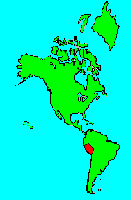SPECIES INFO
Black capped Tinamou (Crypturellus atrocapillus) is found from central Peru south into Bolivia. This 12 inch tinamou has an orange throat. The overall color is brownish, but the upper breast is gray, and the middle breast is reddish brown. The male is slightly darker, and the female is marked dorsally with horizontal yellow thin lines.
There are two subspecies. The nominate subspecies, Crypturellus atrocapillus atrocapillus is found in south eastern Peru. The subspecies garleppi is found in northern Bolivia.The tinamou genus Crypturellus is found from Central America south through much of warmer and tropical South America. There are 21 species in the genus. These are generally small brown to reddish brown birds. Most are between 8 and 12 inches (20 to 30 cm) in length. The yellow leg of SE Brazil can reach 14 inches in length.
Howard and Moore in 2003 included the genera Tinamus (5 species), and Nothocercus (3 species), and Crypturellus (19 species herein. This tribe is found from Mexico south to Bolivia and Argentina. This totals 27 species.
This group is generally found in woodlands.
Tinamous family (Tinamidae) are a group of primitive birds found in South America from southern Mexico to Argentina and Chile. Although Tinamous might resemble quails or grouse, they are perhaps related to the Rheas. However, unlike the Rheas, the Tinamous can fly. Howard and Moore in 2003 counted 47 species spread among 9 genera. Howard and Moore also listed over 100 subspecies including the nominates. Howard and Moore also break the Tinamidae into two tribes: The Tinaminae and the Rhynchotinae.
These are typically found in rain forests and other heavily forested areas. These birds spend most of their lives on the ground, and with their strong legs they can escape many dangers. However, when not feeding they can roost in branches in trees.
Tinamous Order (Tinamiformes) contains one family (Tinamidae). These are a group of primitive birds found in South America from southern Mexico to Argentina and Chile. Although Tinamous might resemble quails or grouse, they are perhaps related to the Rheas. However, unlike the Rheas, the Tinamous can fly. Taxonomists combine the various forms into different arrangements. There are perhaps between 30 and 50 species in this group. (Munroe and Sibley counted 47 species in 1993.)
If these birds are indeed related to the rheas, then placing the rheas into the Struthioniformes is questionable.
Aves contains about 8,650 different species of living birds known to science. Each year about one new species is discovered in some remote rain forest or remote island. In addition, scientists have been raising many subspecies to full species status which may raise the species count to 10,000. Birdlife recognizes 10,027 species as of 2011.
However, each year about one species goes extinct. The rate of extinction is increasing, and the rate of new discovery is decreasing, so that the number of bird species will soon begin to decline rapidly. Although different taxonomists would organize the birds differently, there are approximately twenty-seven orders of birds. These orders are broken down into about one hundred and fifty-five different families.
Recent research of the genetic structure of some of the shore birds and owls would indicate that the present organization of orders and families should have some modification.
The birds are a worldwide group of animals that are characterized by having the front limbs modified into wings that are used for flying. Perhaps the most unique feature of the birds is the feathers. These feathers are made up of a central support called a quill and a series of small filaments that are hooked together as barbs.
For many years it was believed that Archaeopteryx discovered in Bavaria was the oldest bird from about 150 million years ago. However, in l986, Sankar Chattterjee, a Texas paleontologist, reportedly discovered a bird in the genus Protoavis that lived about 225 million years ago.
When this project was begun in 1978, we used Austin & Singer for bird taxonomy. Since then, we have adopted many changes, but have kept some older concepts that are still found widely in the literature. Recently, we have used Clements and Howard & Moore. Very recently, we have used Monroe and Sibley for the higher taxonomy of the perching birds.
Backboned Animals (Phylum Chordata) are the most advanced group of animals on earth. These animals are characterized by having a spinal cord or backbone. Most members have a clearly defined brain that controls the organism through a spinal cord. Fish, amphibians, reptiles, birds, and mammals are in this phylum.
Currently, some taxonomists believe that the fish should be divided into two groups (sharks and regular fishes) and that there are some other primitive groups in the phylum such as hagfish or lampreys.
Animal Kingdom contains numerous organisms that feed on other animals or plants. Included in the animal kingdom are the lower marine invertebrates such as sponges and corals, the jointed legged animals such as insects and spiders, and the backboned animals such as fish, amphibians, reptiles, birds, and mammals.

